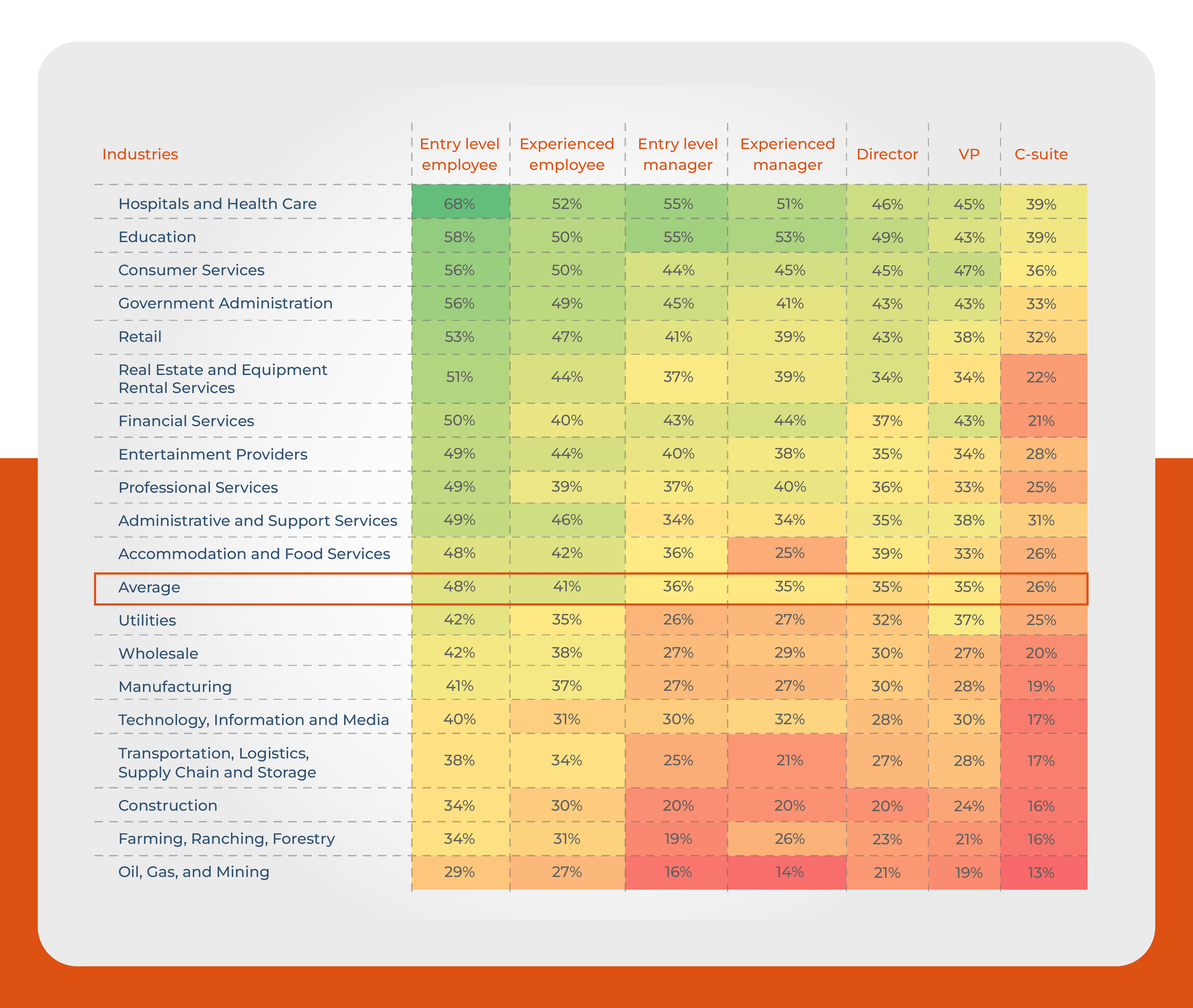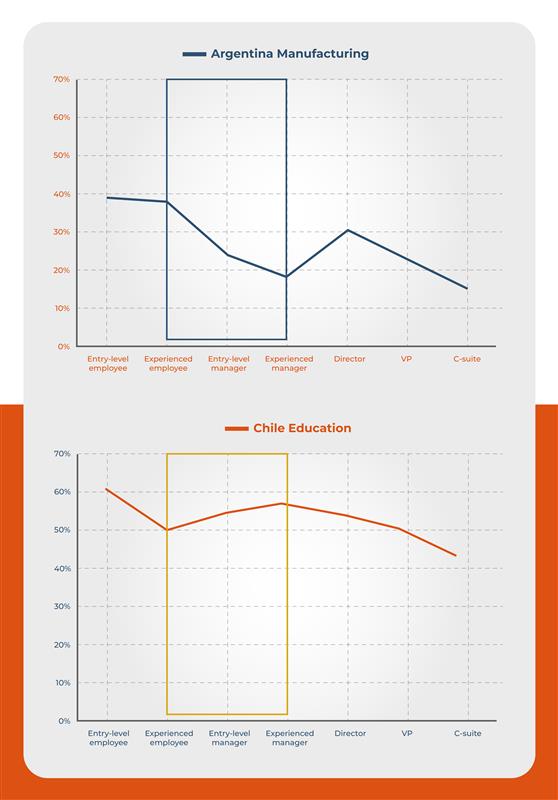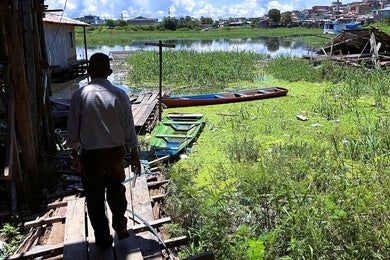Fixing the Broken Rung: How Data Can Help Advance Women’s Careers in Latin America and the Caribbean

Authors: Patricia Yañez-Pagans, Jimena Serrano, Mattia Chiapello, Magdalena Barafani, Casey Weston, Silvia Lara, Alejandra Barrientos.
It has been widely documented that women face challenges in advancing their professional careers (Inter-American Development Bank, 2024), but what is the critical moment? Our analysis, based on aggregated LinkedIn data for Latin America and the Caribbean (LAC), reconstructs what happens at each step toward leadership positions, identifying where women’s participation falls most sharply and how these patterns vary by sector. The findings offer timely insights to inform initiatives aimed at advancing women's careers.
The analysis of LinkedIn data, focused on 18 countries across the region, reveals that women represent 49% of entry-level positions. However, their share drops to 35% in managerial roles and barely reaches 26% in senior executive positions. Access to this data was made possible through an agreement between IDB Invest and LinkedIn under the Development Data Partnership.
The countries included in the analysis are Argentina, Barbados, Bolivia, Brazil, Chile, Colombia, Costa Rica, Dominican Republic, Ecuador, Guatemala, Jamaica, Mexico, Panama, Peru, Trinidad and Tobago, Uruguay, and Venezuela.
It is important to note that LinkedIn’s aggregated data may not comprehensively represent the entire labor market. However, the platform is highly valuable for making relative comparisons between countries and for examining specific “rungs” of the career ladder – from entry-level to executive roles.
This information serves as a critical input for designing public policies tailored to each country, sector, and career stage, while also helping the private sector identify where bottlenecks occur and adopt data-driven measures. The sectoral-country-level analyses were conducted for 8 out of the 18 countries, for which the sample by sector is representative in most industries.
The evidence indicates that not all sectors behave uniformly, consistent with prior literature (Inter-American Development Bank, 2024). Women remain underrepresented in leadership roles in high-income sectors such as oil, gas, and mining, as well as in technology, information, and media. In technology, women hold 40% of entry-level jobs but only 17% of executive roles.
Where Are Women’s Leadership Roles Concentrated?
Our analysis indicates that women’s leadership roles are concentrated in service-oriented industries, particularly in health, education, and consumer services. These sectors exhibit high female representation across all career stages, consistent with previous research. For example, in the health sector, women hold 68% of entry-level positions but only 39% of top management posts.
Share of Women Within Each Role and Specific Sector

Source: authors' own analysis based on LinkedIn data. Simple average of a subset of eight countries whose data is representative of most of their industries: Argentina, Brazil, Chile, Colombia, Costa Rica, Mexico, Panama, and Uruguay.
Why Does Mobility Between Roles and Sectors Matter?
Promoting worker mobility across roles and sectors is crucial for a dynamic economy. The efficient allocation of female and male talent in the labor market helps drive productivity and economic growth (IDB Invest, 2022). Mobility across roles and industries fosters innovation, encourages investment in skills and lifelong learning, and stimulates entrepreneurship and business creation (OECD, 2025). The opportunity for professional advancement is also a key factor in improving workers’ financial stability, quality of life, and job satisfaction and retention (Inter-American Development Bank, 2023).
Using Data to Expand Women's Opportunities
Exploring labor-market data provides valuable insights for designing programs that support professional mobility and help workers transition into high-growth industries. Rather than universal initiatives, data analysis shows the need for targeted actions tailored to each market to address the specific barriers women face in advancing to senior roles.
For this reason, we are deepening our analysis by industry and country to understand specific dynamics. For example, in the manufacturing sector in Argentina, women are slightly underrepresented as individual contributors (approximately 40%); yet, when moving to entry-level leadership positions, there is a significant drop in female representation. In contrast, the progression in the education sector in Chile is relatively flat, with women being overrepresented in earlier stages of career progression and a gradual decline from entry-level to leadership positions.
Our goal is to identify these patterns and, more importantly, understand the factors behind them, to design better-targeted policies that remove barriers and accelerate women’s advancement into decision-making positions.
Share of Women within each role in selected industries in Argentina and Chile

Source: authors' own elaboration analysis based on LinkedIn data.
Unlocking Women’s Leadership Potential
Although women in Latin America and the Caribbean are completing higher education at a faster rate than men and have significantly increased their labor force participation over the past three decades, the evidence suggests that further progress is still needed (Inter-American Development Bank, 2024). Barriers in access to leadership positions continue to limit both women’s potential and the region’s ability to fully harness its talent.
Supporting women’s advancement into managerial roles and encouraging them to transfer their skills to high-growth sectors fosters opportunities for women and serves as a key strategy to expand economic growth across the region.
This research is relevant not only to public policy but also to the private sector. In this regard, IDB Invest has developed specific tools – such as “A Roadmap to Advance Women’s Leadership in Latin America and the Caribbean” – which provide a step-by-step guide for companies to implement effective programs. The publication recommends that firms foster women’s decision-making roles through senior management commitment, internal diagnostics with clear targets, and training programs that combine mentoring and coaching – all accompanied by monitoring and evaluation to ensure sustainable results.
There are also training initiatives that can serve as a foundation for firms in the region. For example, the online course “Female Leadership: Boost Your Skills and Drive Change” – available on the BID Academy platform – offers a free audit version and a paid certificate option that companies can fund for their employees. The course provides practical tools to strengthen leadership, communication, personal branding, and career planning. While these resources are not sector-specific, they offer a flexible foundation that can be adapted to each industry and country.
These are just some of the tools IDB Invest currently offers. As we deepen our analysis and understanding of the landscape, we will continue to build on our experience and offer even more tailored solutions.
LIKE WHAT YOU JUST READ?
Subscribe to our mailing list to stay informed on the latest IDB Invest news, blog posts, upcoming events, and to learn more about specific areas of interest.
Subscribe



